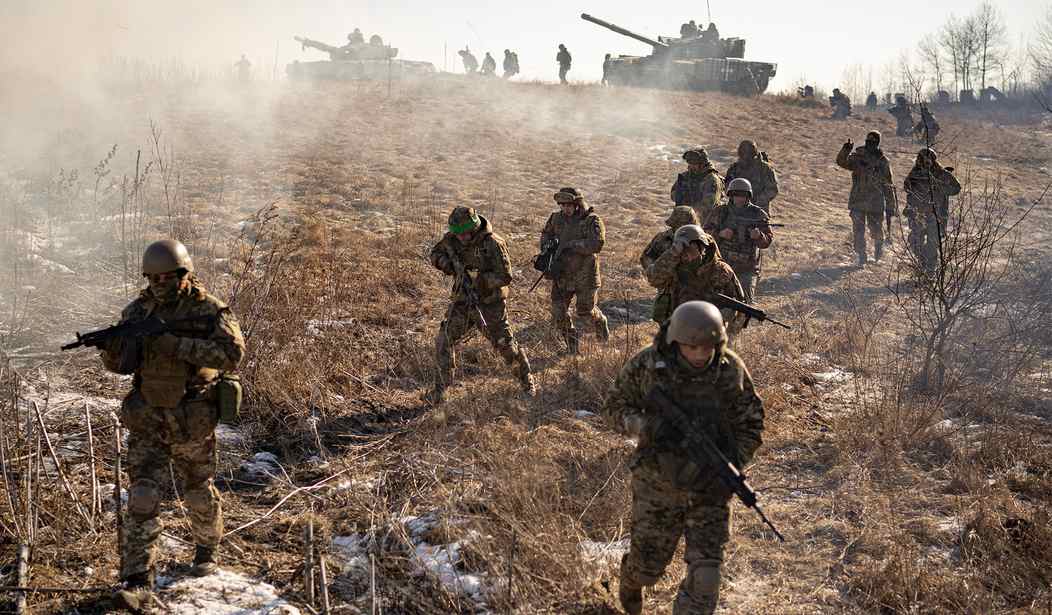Or so we think. Ukraine has stepped up its offensive operations over the last couple of weeks, but those appear to have been “reconnaissance in force” moves to prepare for the larger offensive everyone knew was coming.
Today, however, those operations reached an intensity level that demonstrates a large-scale attack against Russian invaders. It is the first major counterpunch since the liberation of Kharkiv:
The Ukrainian military has launched a long-anticipated counterattack against occupying Russian forces, opening a crucial phase in the war aimed at restoring Ukraine’s territorial sovereignty and preserving Western support in its fight against Moscow. Ukrainian troops on Wednesday night intensified their attacks on the front line in the country’s southeast, according to multiple individuals in the country’s armed forces, in a significant push toward Russian-occupied territory. Four members of the military, including officers, spoke on the condition of anonymity because they were not authorized to publicly discuss the battlefield developments.
Two Ukrainian officials tell ABC News that it’s on like Donkey Kong:
Well-trained Ukrainian troops had been gathering at strategic locations near the front lines in recent days, Western officials said last week.
Two Ukrainian officials, including a source close to President Volodymry Zelenskyy confirmed to ABC News that an active phase of the Ukrainian counteroffensive is underway.
“Well-trained” means NATO-trained in this instance. Ukraine has had its better formations trained by the West for months in anticipation of the eventual counteroffensive. The only suspense was whether Ukraine would have other pieces in place, especially air support/cover and long-range artillery. Either they finally got all of those elements arranged, or their NATO partners got impatient, as the Washington Post suggests.
The Russians think it’s begun as well. In fact, one of their most well-known analysts believe it began nearly a week ago:
“Perhaps, we can now reliably say that the offensive of the Armed Forces of Ukraine began 5-6 days ago,” wrote Strelkov on Telegram, providing analysis of troop movements at different hot spots along the front line.
“At the moment — after a day of continuous fighting, it is indirectly known about minor penetrations, but there are no breakthroughs,” he added, speaking of Ukraine’s forces. He also said that the Russian military would need more troops and the creation of new corps — at least an additional 300,000 military personnel — to be able to successfully launch their own counteroffensive.
Good luck with that. Russia can’t get 300,000 troops to the front line in time to deal with a counteroffensive at this point if they don’t have them already — and they don’t. Their previous mobilizations were disasters from a military-readiness perspective; they got little to no training and didn’t even get fully equipped before being sent out to the front lines. As a result, the Russians have lost many more men than one would otherwise expect, and also lost resources that might have corrected those deficiencies in later mobilizations. And don’t discount the fact that the kind of mobilization Strelkov envisions would create a massive political problem for Vladimir Putin and the oligarchic elites backing him.
That doesn’t make Strelkov wrong about his assessment. If initial reports hold up, Ukraine has launched (or is launching) a multi-pronged attack aimed at cutting off Crimea and potentially splitting the Russian front in several places:
Kyiv said its forces had clawed back territory from Russia in an attack on the flanks of the eastern city of Bakhmut.
Meanwhile, Russian sources claimed Ukraine launched a major new offensive in the southern Zaporizhzhia region, armed with tanks and multi-launch rocket systems.
Probing attacks were reported by analysts in the Luhansk region of the Donbas, as infra-red satellites also picked up an increase in fires in the Kherson area.
The push in Zaporizhzhia may be the most meaningful. Ukraine has a Soviet-era nuclear reactor facility there that has been seized by the Russians and used as leverage by the Kremlin in hopes of forcing a surrender. Ukraine will have to get that back before Russian troops sabotage it as a reprisal, but that’s not the only strategic consideration. The Washington Post notes that a Ukrainian advance there would all but end any hope of connecting Crimea to Russia by land:
Russian military bloggers also reported heavy fighting in the Zaporizhzhia region, a part of the front line that has long been seen as a likely location of the new Ukrainian campaign. By cutting south through the flat fields of Zaporizhzhia, Kyiv’s forces could aim to sever the so-called land bridge between mainland Russia and the occupied Crimean Peninsula, cutting off crucial Russian supply lines.
And Newsweek reports that the Russian milbloggers, while trying to keep a stiff upper lip, are conceding that the Ukrainians have gained ground already:
On Thursday, milblogger War Gonzo said that a battle had been ongoing during the night in Orekhov-Tokmak, writing that the Ukrainian side had not made significant progress.
However, the post described how on the Donetsk front where Russian troops had conducted assault operations in Maryinka “the Ukrainian garrison held its positions” and managed to advance in the Vodiane area.
Meanwhile, Russian troops attempted a counterattack near Kleshcheevka, southwest of Bakhmut, which was not successful. The Ukrainian army, backed by artillery, “managed to occupy several new positions on the southwestern approaches to the city.”
Russian state media war correspondent Alexander Sladkov wrote on Telegram Thursday that, in the Zaporizhzhia direction, “the enemy is moving forward in waves trying to break through our first line of defense.”
One look at the map makes the strategic value of Zaporizhzhia clear for Ukraine. It’s the rough center of the line for the Russians in the western sector of their occupation. If they can break through the lines there, it will not just split Russian forces but make resupply impossible for troops if Ukraine can reach Melitopol and Mariupol. Along with new pressure from Kherson, that would spell the end of Russian control in Crimea.
If, of course, is a very big word in this instance. But with attacks taking place all along the lines farther east as well, Russia has the same problem all invaders have after having lost momentum and too many troops: stasis. That’s why Strelkov says that the Russians need another 300,000 troops ASAP, because they need reserve units to shore up the attack points. They don’t have them, though, and the troops they do have already suffer from low morale and bad supply. If the Ukrainians have the forces and the will — and it appears they have both, especially the latter — those lines will break eventually.
And the destruction of the Kakhovka Hydroelectric Power Plant (KHPP) dam has also changed the game board for the Russians — and not for the better. ISW reports, as do other media outlets, that the resulting flooding has potentially crippled the Russian defense units in the area:
The destruction of the Kakhovka Hydroelectric Power Plant (KHPP) dam is significantly changing the geography and topography of the Kherson frontline sector in southern Ukraine. Near-infrared (NIR) imagery captured at 0400 am ET on June 7 indicates that the flooding is heavily disrupting Russian prepared defensive positions on the east (left) bank of the Dnipro River – especially affecting Russian first-line positions in Hola Prystan and Oleshky. Various sources reported that Oleshky, Hola Prystan, Kozacha Laheri, and Dnipryany are almost entirely flooded with water levels rising to the height of a one-story buildings in some areas.[1] The Ukrainian headquarters established to remediate the consequences of the dam’s destruction reported that as of June 7 29 settlements are partially or fully flooded, 19 of which are located on the Ukrainian-controlled territory and 10 on Russian occupied territories.[2] Russian sources published footage indicating that water had begun receding in Nova Kakhovka and had dropped by 30cm.[3] Russian sources also claimed that water levels decreased by three to four meters in some areas from a high of 10 meters.[4] Water levels in nearby Mykolaiv City reportedly increased by 70cm as of June 7.[5] Flooding will likely worsen and further change the geography in Kherson Oblast over the next 72 hours.
The destruction of the KHPP dam is affecting Russian military positions on the eastern bank of the Dnipro River. The flooding has destroyed many Russian first line field fortifications that the Russian military intended to use to defend against Ukrainian attacks. Rapid flooding has likely forced Russian personnel and military equipment in Russian main concentration points in Oleshky and Hola Prystan to withdraw. Russian forces had previously used these positions to shell Kherson City and other settlements on the west (right bank) of Kherson.Ukrainian Southern Operational Command Spokesperson Nataliya Humenyuk stated that Russian forces relocated their personnel and military equipment from five to 15 kilometers from the flood zone, which places Russian forces out of artillery range of some settlements on the west (right bank) of the Dnipro River they had been attacking.[6] The flood also destroyed Russian minefields along the coast, with footage showing mines exploding in the flood water.[7] Kherson Oblast Occupation Head Vladimir Saldo, however, claimed that the destruction of the KHPP is beneficial to the Russian defenses because it will complicate Ukrainian advances across the river.[8] Saldo’s assessment of the situation ignores the loss of Russia’s first line of prepared fortifications. The amount of Russian heavy equipment lost in the first 24 hours of flooding is also unclear.
Given the outcome of the dam’s destruction, I’d tend to suspect that the Ukrainians took it out. Add in the timing to the step-off for the counteroffensive, and the circumstantial case looks pretty strong indeed. It is, however, an existential war for Ukraine, and while it may cost lives, a frontal assault on those positions would have certainly cost more. (Even so, it’s hardly a definitive case. The Russians have done a lot of stupid, cruel, and counterproductive things in this war.)
Whoever did it, the collapse of the dam does appear to have significantly improved Ukraine’s position in the southwest. Blowing out all of the trenched defenses in this region spares them the costs of a frontal assault on these lines. If this report is accurate, a Ukrainian sweep south out of Kherson would also isolate Crimea even more and force the Russians into a pocket that a pincer operation that the Zaporizhzhia thrust could create.
Now all that’s left is to see how Moscow reacts to this. Putin and his lieutenants are already engaging in verbal warfare amongst each other as the war keeps turning out badly for them. At some point, Putin will have to decide whether he needs to salvage what he can and retreat, or watch his military get degraded to a point where it would take decades to recover.








Join the conversation as a VIP Member